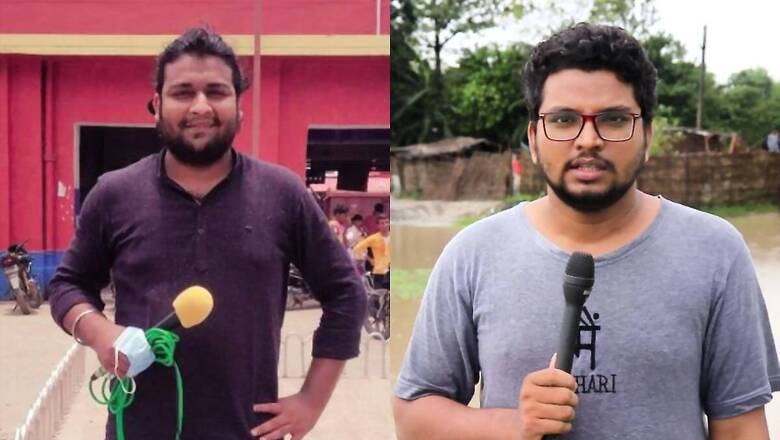
views
The town of Kishanganj on the northern verge of Bihar falls near the River Mahananda. A collective of few districts, including Kishanganj, is located in Seemanchal area, one of the least developed areas in the state. With a low literacy rate and underinvestment in infrastructure, the area remains in news mostly for two reasons: floods and Muslim politics, owing to the high representation of Muslims in the region.
While the mainstream media has failed to raise the local issues, an initiative by a young journalist has brought the region back to news in the digital space.
Tanzil Asif started “Main Media” in 2018 when the full-time journalist left his job in New Delhi and returned to his hometown in Bihar’s Kishanganj. “It was during the Jokihat bypolls in the state in 2018 when I started reporting alone. I started with a smartphone, lapel mic and a selfie stick,” says Asif.
Starting off with interviews of local MLAs and MPs, Asif gradually began doing local stories which were never reported in the mainstream media. “There were many MLAs who were ruling for three or five terms, and when asked about their contribution, they would blame the opposition, state government or even the central government. But my main concern was what were they doing?” says Asif.
The platform, which began over YouTube and Facebook, gradually became a success among the local people. Main Media’s following on Facebook has reached 2.25 lakh, while it has 31 lakh subscribers on YouTube.
“We started interviewing local MLAs and influential leaders for our shows – Vikas tum kahan ho (Where are you development) and Bebak interview (fearless interview). Later, politicians and MLAs stopped coming to my show. They don’t even answer my calls,” says Asif.
While the mainstream media’s reportage is focused on either the major metros or Patna, Asif is trying to report from the underrepresented sections of the Bihari society. And he is not alone. A section of young journalists has started reporting on ground issues over digital platforms.
After the Covid-19 lockdown was announced in March this year, Prashant Rai from Bihar left his job with a news organisation to launch his digital media venture.
“I borrowed a camera from one my friends, a laptop from another and asked for donation from people. I started from Delhi, recording the plight of workers migrating to Bihar on foot. My first video came out on March 25, and I subsequently started making videos,” says Rai.
Prashant began his digital media venture called Junta Junction and received overwhelming response on social media and video platforms. In a month, the channel reached 2 million viewership and another million on Facebook.
“I took a box, pasted a sticker on it saying ‘Support Independent Journalism’ and started asking people for funds in public places. One of my well-wishers gave us a room to function from and we started reporting,” Rai says.
For Rai, Junta Junction was about bringing out stories from the state that were lost in the cacophony of politics and stereotypical stories. “We did a story on a plastic recycling plant and another on sugar mills. Later, the mainstream media started calling me for the story. A lot of mainstream media outlets pick my stories. We want to report on every significant story in the state. After elections, we will get more time for such stories,” adds Rai.
Highlighting the contribution these local and regional media ventures make on the ground, industry experts say such efforts should be encouraged.
“There is something called parachute journalism where big reporters from metro cities used to land up in these areas, use all the resources and use journalists as fixers. It was a normalised pattern. So, it is very important to empower these journalists who are rising from the ground and bringing out real stories. People don’t require saviours from big cities and big newsrooms, they can tell their stories themselves,” says Soma Basu, former fellow at Reuters Institute for the Study of Journalism and researcher at Delhi’s Jamia Millia Islamia.
But media outlets require money to sustain and chase news. For Main Media, this has been has been an ironic turn. “When we started asking for donations, initially we got good response, but it dried up after some time. Facebook and YouTube don’t pay enough to sustain the media house,” says Asif. “We had a collaboration with Like App and we were on the final stages of collaborating with TikTok. They were entering into the news genre and they had started taking our content and targeting local audiences. But after the boycott of Chinese apps, it failed,” adds Asif.
Junta Junction has fared well to meet its daily need for revenue. “I have travelled to around 30 districts in Bihar. We have reached out to areas that the mainstream media hasn’t penetrated. When I had to go somewhere for reporting, I appeal to people in the area on social media for food and shelter. People do help, they wait for me with food. Some pay for my fuel,” Prashant says.
He adds that once a boy from Bhagalpur got 25 T-shirts printed with “Janta Junction” on it, helping them with publicity.
“Various studies have shown that the newsrooms are controlled by privileged upper caste people or people belonging to the majority. So, if someone is bringing out the voice from remote areas, I think that these journalistic ventures should be encouraged as much as possible,” Soma Basu says.
Part of this digital brigade are Seher and Ribhu who started bringing out stories from rural India, looking at the idea of “development” through the lenses of culture, environment, health, and sustainability. Their weekly newsletter ‘REH’ focusses on the issues of migrant workers, health and rural India.
While most of the news ventures are being run by two or more people, Umar Ashraf, a journalism student, from Bihar’s Barh is a one-man army, capturing the local issues with a mobile phone and a Gimble. Ashraf started capturing parallel history of the Indian freedom movement and its unsung heroes who remained unrecognised under piles of history books in library for his website ’Heritage Times’. Umar’s videos are full of insights, interviews, humour and the plight of people who fail to reach the television screens.
“In India, there is a lot of competition among media houses. The big organisations and non-profit organisations should reach out to these small groups. Organisations should stop looking at these ventures as competitors, but (view them as) allies,” Basu says.
Read all the Latest News and Breaking News here


















Comments
0 comment